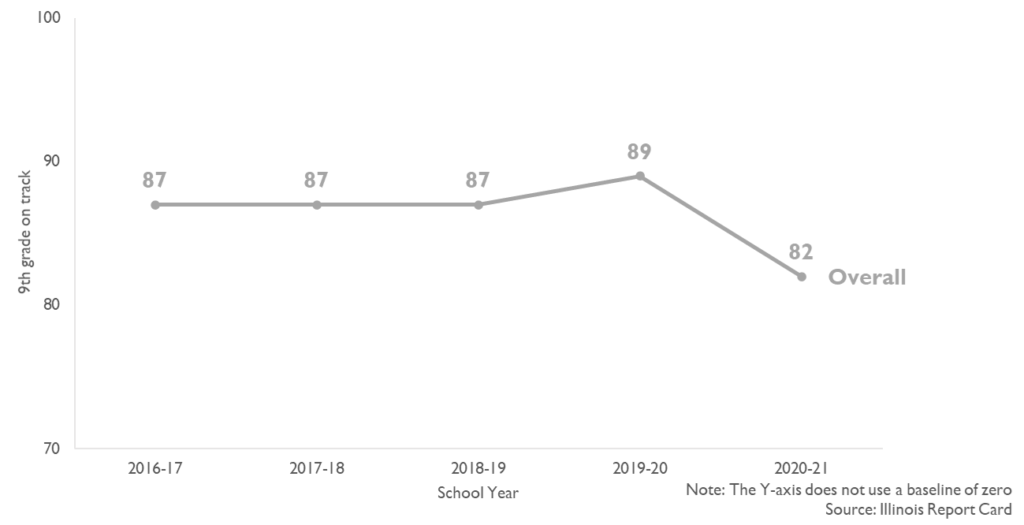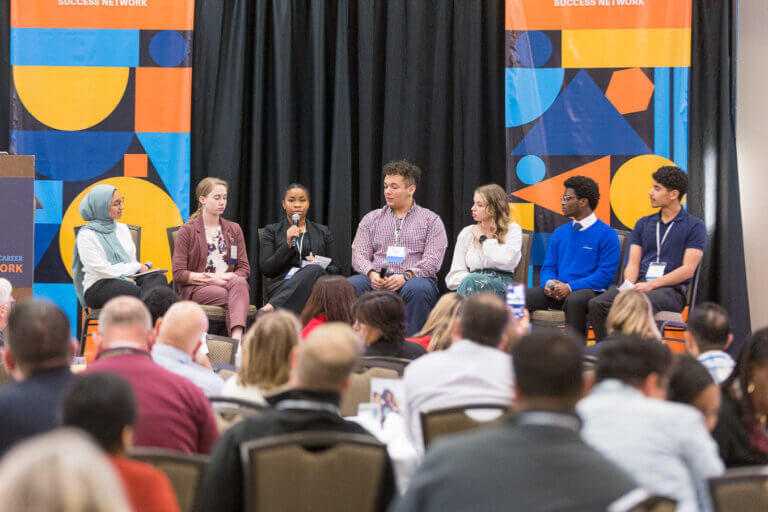Each year, we look forward to when the Illinois State Board of Education releases new data on the Illinois Report Card, the official source for data and information describing K-12 public schools in communities statewide. Recently, ISBE published the school year 2020–21 version. Below we describe several key metrics in college and career readiness, including 9th grade on track, four-year graduation rate, postsecondary enrollment, high school dual credit enrollment, and community college remedial enrollment.
Ultimately, while there were some disappointing areas in the data, we still found some cause for celebration. Certainly, the COVID-19 pandemic has disrupted learning for students of all ages across Illinois, the impacts of which are reflected in several critical measures. For example, 9th grade on-track, high school graduation, and postsecondary enrollment rates all declined. Despite these areas for growth, increasing dual credit enrollment and declining postsecondary remediation enrollment rates are causes for celebration. We believe that by implementing strategic innovations through early college credit and transitional instruction, we can cultivate systems that will support students to succeed in an ever-evolving context.
9th Grade On-Track Rate Fell Substantially in School Year 2020–21
Unfortunately, the percentage of 9th grade students on track to graduate from high school fell approximately seven percentage points between school years 2019–20 (89%) and 2020–21 (82%). This decrease is substantial year-over-year and longitudinally, as the 2020–21 rate also represents a five-percentage-point decrease from its 2016–17 counterpart (87%). We largely attribute these declines to the disruptions impacting students throughout the P-20 pipeline, and increased focus on getting these students back on track through innovative secondary practices will be essential moving forward.

Four-Year Graduation Rate Regressed Overall and Across Racial/Ethnic Subgroups for High School Graduating Class of 2021
The overall four-year graduation rate fell to 86% for the high school graduating Class of 2021—a regression from the relative peak of 88% for the Class of 2020. The 2021 rate is like counterparts for the Classes of 2019 (86%) and 2018 (86%). This pattern extends to racial/ethnic subgroups, with Black, Hispanic, and white subgroups each erasing gains for the Class of 2020 and decreasing the rates for the Class of 2019. Certainly, these declines indicate a need for strategic intervention that will put students on a path toward graduation, and we especially emphasize the need to consider how various supports may be needed to narrow equity gaps in rates by demographic subgroups.

Declining Postsecondary Enrollment Continued for High School Graduating Class of 2019
Postsecondary enrollment rate within twelve months of graduation decreased for the high school graduating Class of 2019 (69%) from the rates for the Classes of 2018 (70%) and 2017 (73%), respectively. Disaggregating by type of institution, enrollment at four-year universities stagnated over time (40% enrollment for the Class of 2017, 41% for the Class of 2018, and 40% for the Class of 2019). By comparison, enrollment at community colleges tracked with the overall rate, declining three percentage points between the Classes of 2017 (32%) and 2019 (29%). The declines in the last year mirror national trends in postsecondary enrollment and indicate a need to implement strategies to smooth student transitions into postsecondary, such as scaling college and career pathway approaches and transitional instruction.

Statewide Dual Credit Enrollment Continued Rising
Building from prior increases, the number of high school students enrolling in dual credit coursework rose year-over-year for school year 2020–21. Approximately 40.0% (n = 79,370) of high school students taking early college coursework (N = 198,474) took at least one dual credit course. That total compares to 69,995 students (approximately 36.5% of N = 191,818) in school year 2019–20.
Notably, dual credit enrollment among Black students rose approximately 34.5% from school year 2019–20 (n = 6,773) to school year 2020–21 (n = 9,109). Among Hispanic students, enrollment rose approximately 26.3% year-over-year, from 13,583 students in school year 2019–20 to 17,161 students in school year 2020–21. These increases compare with an approximate 5.2% increase year-over-year among white students. Increasing dual credit participation is worth celebrating, as we know from the annual Illinois Community College Dual Credit report that participation is related to positive postsecondary outcomes down the line. Further, we are excited to see how dual credit can drive more equitable access and success for Black and Hispanic students, specifically.

Overall Remediation and Remedial Mathematics Enrollments Declined Substantially Class Over Class
Community college remediation rates fell markedly for the high school graduating Class of 2019 relative to the Class of 2018. Approximately 39.1% (n = 15,955) of graduates from the Class of 2019 who enrolled at an Illinois community college (N = 40,830) took at least one remedial course in any subject. This rate represents more than a four-percentage-point decrease from the rate for the Class of 2018 (43.4%, n = 18,155) and extends the downward trend from 2017 (44.2%, n = 17,405), 2016 (45.7%, n = 19,506), and 2015 (46.8%, n = 19,388). The rate also represents a nearly ten-percentage-point decrease from the rate for the Class of 2013 (48.7%, n = 19,427)—the first year of data available on the Illinois Report Card.
Decreasing remedial mathematics enrollment is driving the overall decrease. Approximately 29.4% (n ≈ 12,0041) of community college enrollees from the Class of 2019 took a remedial math course. This rate represents a drop of just under nine percentage points—and nearly four thousand enrollees—from the 38.2% enrollment rate for the Class of 2015 (n ≈ 15,8392), and a nearly twelve-percentage-point decrease from the rough 41.0% enrollment rate for the Class of 2013. While we were disappointed to see declining postsecondary enrollments, we are heartened by the greater success of students placing into credit-bearing coursework upon matriculation into community colleges. As we anticipated in our blog post covering last year’s data, we are excited to see how the continued scaling of transitional math and multiple measures placement are contributing to greater student success at the postsecondary level.
Remedial English enrollment, reflected on the Illinois Report Card as remedial communications, decreased slightly class over class. Approximately 19.2% (n ≈ 7,8393) of community college enrollees from the Class of 2019 took a remedial English course. This rate represents an approximate one-and-one-half-percentage-point decrease from its counterpart for the Class of 2018 (20.7%, n ≈ 8,6614), which itself is similar to the rate for the Class of 2013 (~20.0%). We anticipate more substantial declines in remedial communications as statewide scaling of transitional English courses takes hold. Now that the official course parameters, competencies, and policies have been finalized and portability processes initiated, we expect to see this innovative practice begin to impact students statewide. Despite these areas for celebration, we continue to advocate for remediation data to be reported in a disaggregated fashion. We believe it is essential to spotlight and address differential remediation enrollment rates among Black, Hispanic, and white students.



